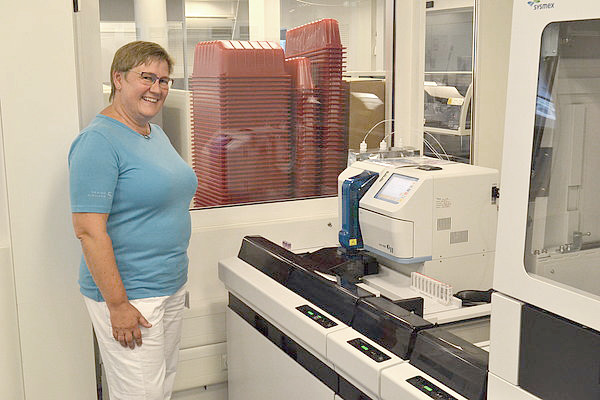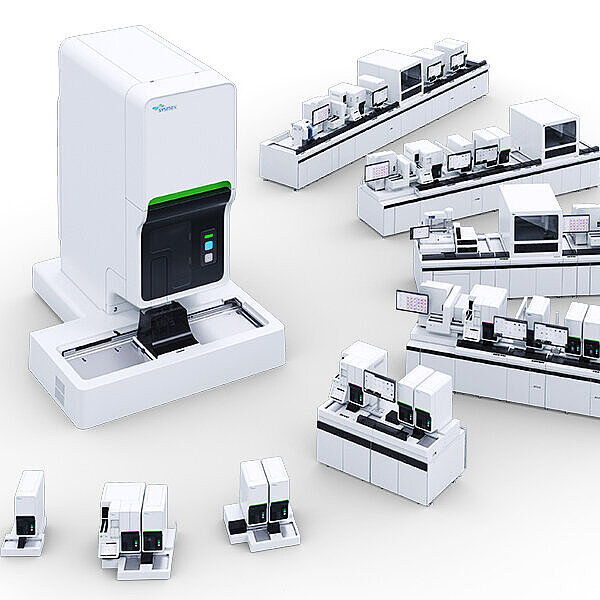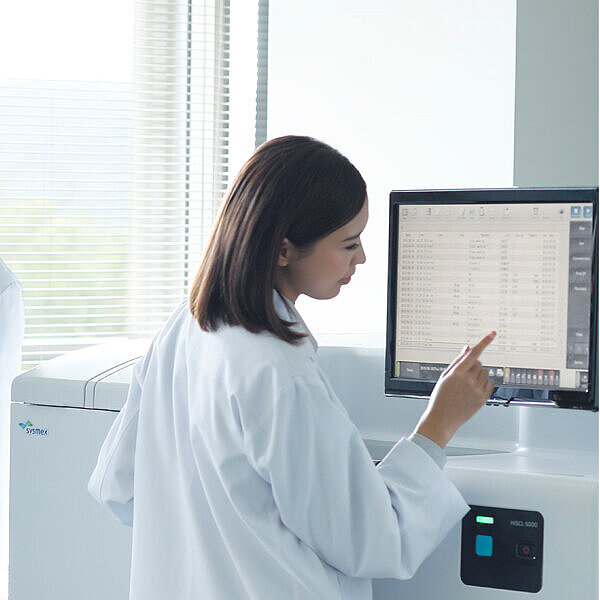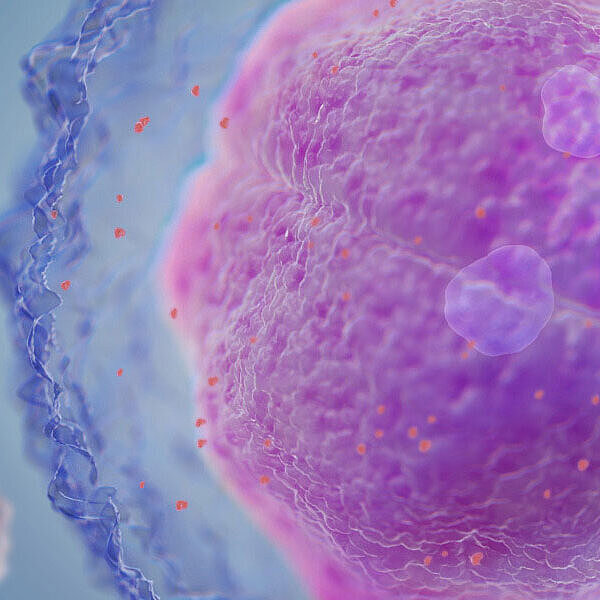Holbæk Tosoh G11 integrated in the Sysmex XN-9000 solution
General introduction
Holbaek hospital in Denmark was constructed in 1844 as a 2-story building holding 40 beds. More buildings and wards have been added and now Holbaek hospital is part of 4 emergency hospitals in the region of Sealand with a capacity of 344 beds, covering an area of more than 200.000 inhabitants.
In the laboratory at Holbaek hospital, 60 laboratory technicians work in shifts around the clock to handle blood sampling, analysis, instrument maintenance and quality control. The laboratory at Holbaek hospital handles blood from out-patients, in-house patients and samples from general practitioners, which they receive twice a day.
Bettina Madsen-Mogensen is one of four leading laboratory technicians at Holbaek laboratory, where she has worked for 15 years. Bettina Madsen-Mogensen has been responsible for the HbA1c analysis for 11 years. During her time in the laboratory, she has worked with Tosoh G5, G7, G8 and now Tosoh G11. The Tosoh G11 has only recently been connected to the XN-9000 automation line from Sysmex, which includes three XN-10 analysers, the smear workflow solution with SP-10 stain and smear instrument, as well as the DI-60 automated digital morphology instrument and the TS-10 tube sorter.
Diabetes in DenmarkIn Denmark more than 280.000 people are diagnosed with diabetes, whereas 252.000 has diabetes type-2 and 28.000 has diabetes type-1. |
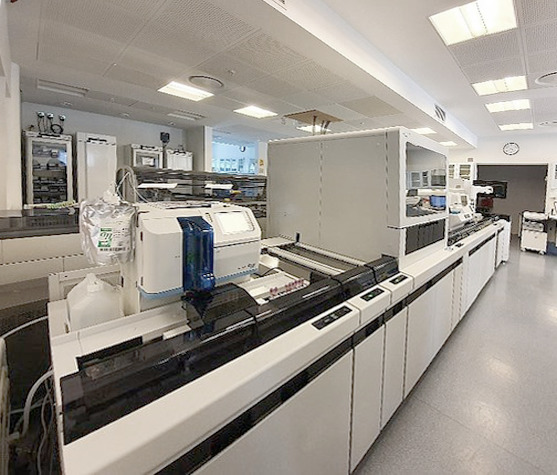
The laboratory’s set up
Since the laboratory started using Tosoh for HbA1c testing and Sysmex haematology analysers in 2012, they have consolidated their EDTA tubes, for both haematology and HbA1c. This way the laboratory handles much fewer tubes per day. In 2020 the laboratory decided to integrate their Tosoh G11 glycohaemoglobin analyser to their current haematology line. This was not possible with their setup as it was, so with the help of Sysmex technicians, a turn-unit and a tube sorter from Sysmex were installed and the new setup fitted perfectly into the laboratory.
What were the challenges in determining HbA1c?
The decision to consolidate EDTA tubes has reduced the total amount of EDTA samples the laboratory has to handle. Before the integration of the Tosoh glycohaemoglobin analyser in the XN-9000 line, consolidation of the EDTA tubes introduced a change in the way the laboratory technicians handled the samples. After analysing the samples in the Sysmex haematology analysers, the HbA1c tubes are sorted into Sysmex racks by the integrated tube sorter and sorted out to the stock yard. The laboratory technicians then had to manually transfer the tubes into Tosoh racks with the barcode facing forward and put them on the Tosoh G8 stand-alone analyser.
After the measurement, the samples again had to be transferred to separate racks and stored in the refrigerator.
Besides the samples from out-patients and in-house patients, the laboratory receives samples from General Practitioners (GP) twice a day at noon and again at 16:00. GP EDTA samples are pre-sorted in Sysmex racks when they arrive at the laboratory and are directly loaded on the Sysmex XN-9000 line. After the analysis from the haematology analysers, the afternoon/evening staff move the HbA1c samples from Sysmex racks and place them into Tosoh racks with the barcode facing forward. Once the GP samples are completed in the evening, all other HbA1c samples are stored until the next day.
The sample sorting on the Sysmex XN-9000 automation line had been automated, but HbA1c samples still had to be handled and moved many times during the day, both before and after analysis.
Bettina Madsen-Mogensen often got the question asking when the Tosoh analyser would be integrated into the Sysmex XN-9000 automation line.
The robustness and reliability of the G8 allowed for the laboratory to keep it and use it for β-thalassaemia in the future. |
How was the change to the new instrument for the lab?
The Tosoh G8 which had been installed since 2008 and needed to be replaced in 2019. The laboratory did some research and asked different laboratories before publishing a tender for the HbA1c analyser. As a demand in the tender, the analysis method had to be HPLC, to identify the variants and other haemoglobinopathies. The tender was awarded to the Tosoh G11 glycohaemoglobin analyser because of the speed of the instrument, the HPLC analysis method, and the fact that it could be connected to automation lines.
Bettina Madsen-Mogensen was not alone in the decision to change to Tosoh G11. The chief laboratory doctor and the laboratory chemist were also involved in the decision making and later implementation of the Tosoh G11. Changing from G8 to G11, all laboratory technicians working in shifts were affected and had to be trained. As the Tosoh G11 is very user friendly, this was no major task and the staff quickly mastered reagent change and filter change. Filter change is also much easier than on the Tosoh G8 and the Tosoh G11 can handle 600 injections per filter instead of 400 on the Tosoh G8.
Because the Tosoh G11 is faster than the Tosoh G8, the chromatogram is also different with different areas for the common variants (HbA, HbD, HbS and HbE) which meant that laboratory technicians working with HbA1c daily had to be trained in Tosoh G11 chromatogram interpretation to be able to read and validate HbA1c results and identify variants.
To make sure the results were comparable, the Tosoh G11 was validated against their Tosoh G8. Known variants were also analysed to make sure the Tosoh G11 could detect them and compensate correctly for common variants. The Tosoh G11 was also validated using controls from Tosoh Bioscience and calibrators from DEKS (Danish institute for external quality assurance for laboratories in the health sector).
From stand-alone to Automation
The G11 was first installed as a stand-alone analyser and this meant that the workflow for HbA1c samples did not change much. The real change happened when the Tosoh G11 glycohaemoglobin analyser was modified to fit the Sysmex XN-9000 automation line.
The Sysmex solutions are highly adaptable and flexible towards the specific laboratory needs and in the case of Holbaek, Sysmex specialists designed a solution that delivered functionality in a challenging space. To ensure the fully automated functionality of the integrated Tosoh G11 and the TS-10 tube sorter within a restricted space, a turnunit was planned, resulting in an L-shape automation line. When the Tosoh G11 was installed on the Sysmex XN-9000 automation line, the staff only needed to be trained in handling HbA1c tubes on the Sysmex automation workflow which included the tube sorter (TS-10) and as the Tosoh G11 had already been validated as stand-alone, no further validation was needed.
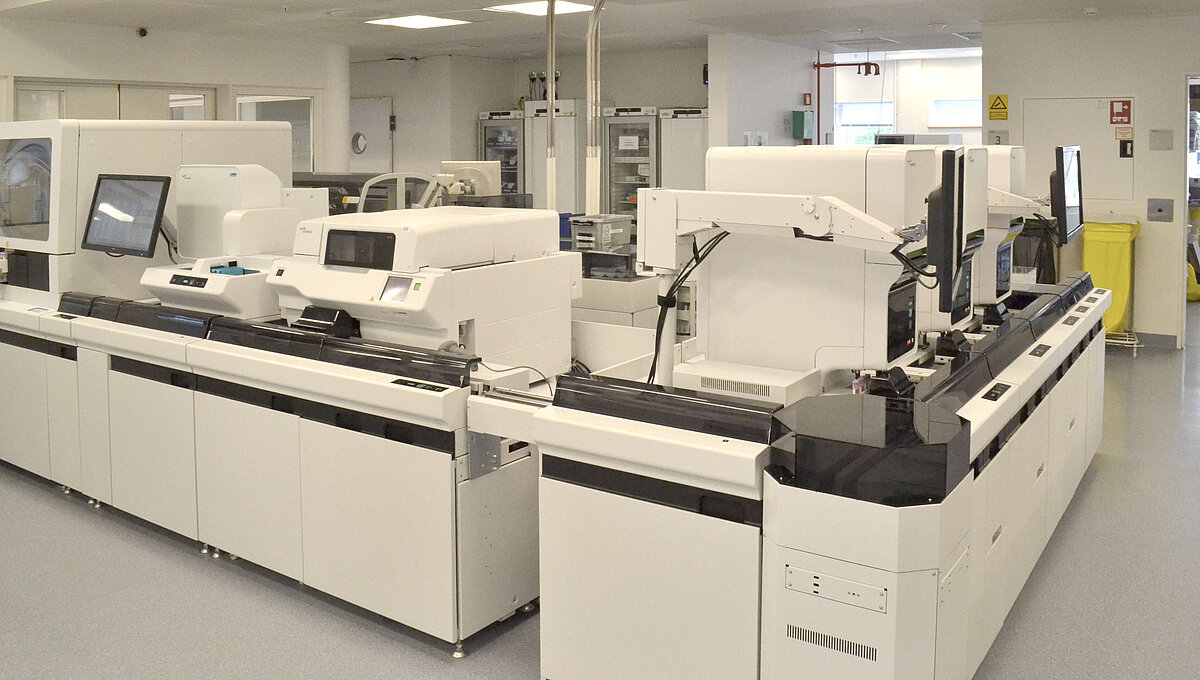
TS-10 added value
|
Tosoh G11 added value
|
Where have you experienced improvements in your workflow?
Bettina Madsen-Mogensen is very keen to share how their workflow changed
After the installation of the Tosoh G11 glycohaemoglobin analyser integrated on the Sysmex automated haematology XN-Series line, manual sample handling is almost non-existent. When the laboratory receives samples in-house or from GP’s, the samples are loaded in Sysmex racks and loaded on the Sysmex automation line. We don’t have to touch either haematology or HbA1c samples again until they are fully analysed.
Since we have the medical joint outpatient clinic in the hospital, we promise the endocrinologists a fast turnaround time (TAT) of 30 minutes in case the patients has to go to further consultations. The Tosoh G11’s fast analysis time of 60 seconds helps us in achieving this.
Since there is very little hands-on required on the analyser and almost no manual sample handling, we almost don’t notice the analyser anymore, it just runs day and night. The stability of both the Tosoh G7 and Tosoh G8 is also the same in the Tosoh G11 analyser, which makes it a perfect automation solution.
The greatest improvement we have achieved is in the evening and night shift. As there are fewer people at work, they can focus on other things than moving samples from one analyser to another. With Extended IPU we have integrated HbA1c validation with haematology validation, which means that all analyser results can be validated from the same place in the laboratory and we don’t have to walk to different analysers to validate results.
Bettina Madsen-Mogensen’s final thoughts
Even though the analyser is almost ‘invisible’ in the daily routine, we have noticed a big improvement in the turnaround time (TAT)
for HbA1c samples. The HPLC technology allows us to see variants. Variants which otherwise could go unnoticed if using other HbA1c analysis methods and could potentially provide incorrect HbA1c results and wrong diagnostics of Diabetes Mellitus.
The Tosoh G11 analyser is very easy to operate, there is almost no maintenance, and it rarely breaks down. There is a leakage
indicator for the column and the filter change is also much easier on the G11 than it was on the G8.
